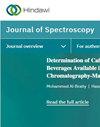基于压缩感知的水质紫外可见光谱数据校正方法研究
IF 2.1
4区 化学
Q4 BIOCHEMICAL RESEARCH METHODS
引用次数: 4
摘要
水中悬浮粒子引起的浊度干扰严重影响了紫外可见光谱法检测水质化学需氧量的准确性。基于此,应用紫外可见光谱法检测水质化学需氧量通常需要物理和数学方法对浑浊度引起的光谱基线干扰进行校正。针对传统校正方法响应速度慢、补偿效果不稳定的问题,本文提出采用压缩感知算法进行基线校正,取得了较好的效果。在实验中,我们选取了甲肼浊度溶液和草酸钠标准溶液,对紫外可见光谱法检测水质化学需氧量的浊度校正算法进行了研究。实验获得了不同浓度的甲醛浊度溶液和相同浓度的草酸钠与不同浊度标准溶液在210 ~ 845 nm的吸收光谱,并分析了吸光度对浊度的非线性影响。本文采用标准溶液实验探索压缩感知理论用于浊度校正,并通过对实际水样的吸收光谱进行校正,验证了压缩感知理论用于浊度校正的可行性。该方法有效地纠正了悬浮颗粒引起的水质紫外可见吸收光谱的基线偏移或漂移,同时保留了紫外光谱的吸收特性,可以有效地提高紫外可见光谱水质化学需氧量检测的准确度和准确度。本文章由计算机程序翻译,如有差异,请以英文原文为准。
Research on Correction Method of Water Quality Ultraviolet-Visible Spectrum Data Based on Compressed Sensing
The turbidity interference caused by suspended particles in water seriously affects the accuracy of ultraviolet-visible spectroscopy in detecting water quality chemical oxygen demand. Based on this, the application of ultraviolet-visible spectroscopy to detect water quality chemical oxygen demand usually requires physical and mathematical methods to correct the spectral baseline interference caused by turbidity. Because of the slow response speed and unstable compensation effect of traditional correction methods, this paper proposes to use a compressed sensing algorithm to perform baseline correction and achieve good results. In the experiment, we selected formazin turbidity solution and sodium oxalate standard solution and carried out the research on the algorithm of turbidity correction for detecting chemical oxygen demand of water quality by ultraviolet-visible spectroscopy. The experiment obtains the absorption spectra of different concentrations of formazine turbidity solutions and the same concentration of sodium oxalate with different turbidity standard solutions at 210∼845 nm and analyzes the nonlinear effect of absorbance on turbidity. This article uses standard solution experiments to explore the compressed sensing theory for turbidity correction, and through the correction of the absorption spectrum of the actual water sample, it verifies the feasibility of the compression theory for turbidity correction. The method effectively corrects the baseline shift or drift of the water quality ultraviolet-visible absorption spectrum caused by suspended particles, while retaining the absorption characteristics of the ultraviolet spectrum, and it can effectively improve the accuracy and accuracy of the ultraviolet-visible spectroscopy water quality chemical oxygen demand detection.
求助全文
通过发布文献求助,成功后即可免费获取论文全文。
去求助
来源期刊

Journal of Spectroscopy
BIOCHEMICAL RESEARCH METHODS-SPECTROSCOPY
CiteScore
3.00
自引率
0.00%
发文量
37
审稿时长
15 weeks
期刊介绍:
Journal of Spectroscopy (formerly titled Spectroscopy: An International Journal) is a peer-reviewed, open access journal that publishes original research articles as well as review articles in all areas of spectroscopy.
 求助内容:
求助内容: 应助结果提醒方式:
应助结果提醒方式:


